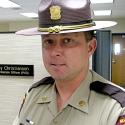
Question: The first snow storm of the season seemed to catch a lot of us by surprise. Can you talk about what to do to be ready for winter travel? Thank you and be safe.
Answer: You are correct, and it comes down to being prepared. While summer months are the deadliest on Minnesota roads, wintertime leads to the most crashes and poses safety risks and hazards.
Here are some tips to help stay safe on the roads in the winter:
•Avoid unnecessary travel if conditions are too poor.
•Buckle up, and make sure child restraints are secured tightly. It is recommended to use bulky clothes and blankets on top of the child restraint harness, not beneath, to ensure harness restraints fit properly.
•Drive at safe speeds according to road conditions, and provide for plenty of travel time.
•Increase safe stopping distance between vehicles.
•Use extra precautions when driving around snowplows by keeping at least five car-lengths behind plows.
•If skidding, remain calm, ease foot off the gas, and turn the steering wheel in the direction you want the front of the vehicle to go.
•If vehicle has an anti-lock braking system, apply a steady firm pressure to the brake pedal. Never pump anti-lock brakes.
•Clear snow and ice from vehicle windows, hood, headlights, brake lights and directional signals.
•Headlights must be turned on when it is snowing or sleeting.
•Do not use cruise control on snow-covered, icy or wet roads.
•Equip vehicles with a scraper and brush, small shovel, jumper cables, tow chain, and a bag of sand or cat litter for tire traction. Blankets, heavy boots, warm clothing and flashlights are also important, as are storing high-energy foods such as chocolate or energy bars.
•Be sure cell phones are charged for long trips, and inform family of destination plans and schedule.
•If stranded, stay in the vehicle.
•Parents of teen drivers should make sure new motorists experience snow and ice driving in a safe environment, such as an empty parking lot.
•For weather-related road condition information, call 5-1-1 or visit www.511mn.org.
Question: I noticed several freshly killed deer on the side of the highway yesterday. What are the traffic-related requirements when someone collides with a deer, and what are the game-related requirements with killing a deer? Is it legal to take the deer home?
Answer: If you are involved in a vehicle vs. deer/large animal crash, call 911 to report if there are occupant injuries, your vehicle is disabled, your vehicle or the animal is in the lane of traffic, or if the animal has been injured and is unable to run away. Law enforcement will be dispatched to your location to assist. It is important to stay in your vehicle so you do not put yourself in danger of getting struck by a passing vehicle.
The Minnesota State Patrol issues permits for road-kill deer generally at the time of the crash or soon after. Any Minnesota resident may claim a road-killed animal by contacting a law enforcement officer. An authorization permit can be issued, allowing the individual to lawfully possess the animal.
Tips to avoid deer crashes:
•Drive at safe speeds.
•Be especially cautious from 6 to 9 p.m. when deer are most active.
•Use high beams when possible at night, especially in deer-active areas.
•Do not swerve to avoid a deer. Swerving can cause motorists to lose control and travel off the road or into oncoming traffic.
•Watch for the reflection of eyes and silhouettes on the shoulder of the road. If anything looks suspicious, slow down.
•Reduce speeds in areas known to have a large deer population -- such as areas where roads divide agricultural fields from forest land and whenever in forested areas between dusk and dawn.
•Deer are unpredictable — they may stop in the middle of the road and change direction when crossing or move toward an approaching vehicle. Blow horn to urge deer to leave the road.
•If a deer is struck but not killed, keep your distance as deer may recover and move on.
•Avoid all distractions while driving.
You can avoid a ticket — and a crash — if you simply buckle up, drive at safe speeds, pay attention and always drive sober. Help us drive Minnesota Toward Zero Deaths.
If you have any questions concerning traffic related laws or issues in Minnesota send your questions to Sgt. Troy Christianson – Minnesota State Patrol at 2900 48th Street NW, Rochester MN 55901-5848. (Or reach
him at, Troy.Christianson@state.mn.us)








